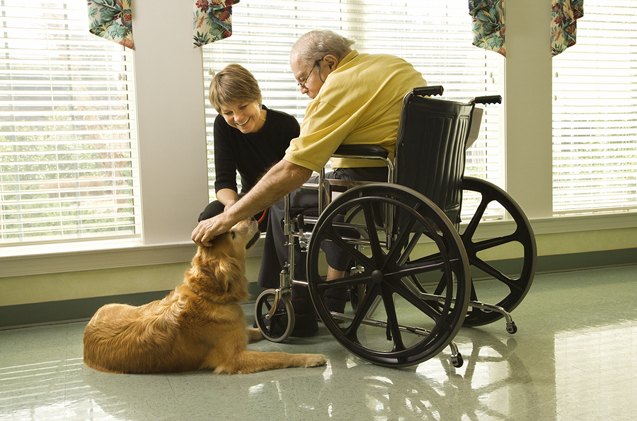Lending A Helping Paw: What’s Involved In Therapy Dog Training

Having a dog can be a wonderful experience – not only do they provide constant love and companionship, but the presence of a dog can be soothing. This is why dogs make such great therapy animals! If you have ever considered training your dog to be a therapy dog, this article is the perfect place to start for more information.
Related: Top 10 Therapy Dog Breeds
Where are Therapy Dogs Used?
The term “therapy dog” is sometimes confused with the term “service dog.” Service dogs are used by individuals with various disabilities to help them perform basic living functions. Therapy dogs, on the other hand, visit certain facilities simply for the sake of providing canine comfort. The most common venues for therapy dogs are hospitals, assisted-living complexes, hospice centers, and schools. In reality, however, therapy dogs can be a benefit almost anywhere. The American Kennel Club (AMK) states that there are currently more than 50,000 registered therapy dog-owner teams in the United States alone and the fact that this number is steadily increasing points toward the fact that therapy dogs provide a real benefit. For example, a study conducted by Alternative and Complementary Therapies showed that a single 12-minute session with a therapy dog reduced blood pressure and anxiety in patients suffering from heart failure.
Related: Amazing Therapy Dogs Help Diabetics Live Healthier, Happier Lives
How are Therapy Dogs Certified?
In order to become a certified therapy dog, your pooch must pass certain requirements put forth in a test conducted by a Therapy Dogs International (TDI) certified evaluator. To qualify for the test, your dog must be at least one year old, in good health, and of good temperament. In order to be a good therapy dog, your dog should be trained for basic obedience and he should be socialized around people and hospital equipment. When it comes to selecting dogs to be therapy dogs, temperament is more important than the particular breed, or even the size of the dog. All you need to do is register your dog with a national group and pass the in-person exam.
How to Get Started
Before you attempt to get your dog certified as a therapy dog, you need to cement his basic obedience skills – these will be tested in the in-person exam. If you want to ensure that your dog picks up what he needs to know, you should think about enrolling in a therapy dog training course sponsored by Therapy Dogs International, Pet Partners, or another national organization. It also wouldn’t hurt to familiarize your dog with the type of people and equipment he will come into contact with as a therapy dog – this includes individuals in wheelchairs, hospital gurneys, electronic equipment, and other devices. The more socialized your dog is, the better he will do as a therapy dog. In the end, however, the thing that matters most is his temperament and his ability to provide comfort to individuals in need.
It takes more than just a friendly disposition to become a therapy dog. But the time you put into therapy dog training will pay off, and you and your dog will make a difference in the lives of people who need the love of a furry friend.

Kate Barrington is the loving owner of two cats (Bagel and Munchkin) and a noisy herd of guinea pigs. Having grown up with golden retrievers, Kate has a great deal of experience with dogs but labels herself a lover of all pets. Having received a Bachelor's degree in English, Kate has combined her love for pets and her passion for writing to create her own freelance writing business, specializing in the pet niche.
More by Kate Barrington























